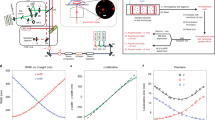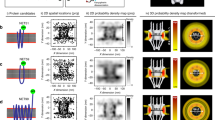Abstract
The nuclear pore complex (NPC) mediates all exchange between the cytoplasm and the nucleus. Small molecules can passively diffuse through the NPC, whereas larger cargos require transport receptors to translocate1. How the NPC facilitates the translocation of transport receptor/cargo complexes remains unclear. To investigate this process, we tracked single protein-functionalized quantum dot cargos as they moved through human NPCs. Here we show that import proceeds by successive substeps comprising cargo capture, filtering and translocation, and release into the nucleus. Most quantum dots are rejected at one of these steps and return to the cytoplasm, including very large cargos that abort at a size-selective barrier. Cargo movement in the central channel is subdiffusive and cargos that can bind more transport receptors diffuse more freely. Without Ran GTPase, a critical regulator of transport directionality1, cargos still explore the entire NPC, but have a markedly reduced probability of exit into the nucleus, suggesting that NPC entry and exit steps are not equivalent and that the pore is functionally asymmetric to importing cargos. The overall selectivity of the NPC seems to arise from the cumulative action of multiple reversible substeps and a final irreversible exit step.
This is a preview of subscription content, access via your institution
Access options
Subscribe to this journal
Receive 51 print issues and online access
$199.00 per year
only $3.90 per issue
Buy this article
- Purchase on Springer Link
- Instant access to full article PDF
Prices may be subject to local taxes which are calculated during checkout




Similar content being viewed by others
References
Peters, R. Translocation through the nuclear pore: Kaps pave the way. Bioessays 31, 466–477 (2009)
Stewart, M. Molecular mechanism of the nuclear protein import cycle. Nature Rev. Mol. Cell Biol. 8, 195–208 (2007)
Weis, K. The nuclear pore complex: oily spaghetti or gummy bear? Cell 130, 405–407 (2007)
Frey, S. & Gorlich, D. A saturated FG-repeat hydrogel can reproduce the permeability properties of nuclear pore complexes. Cell 130, 512–523 (2007)
Frey, S., Richter, R. P. & Gorlich, D. FG-rich repeats of nuclear pore proteins form a three-dimensional meshwork with hydrogel-like properties. Science 314, 815–817 (2006)
Ribbeck, K. & Gorlich, D. Kinetic analysis of translocation through nuclear pore complexes. EMBO J. 20, 1320–1330 (2001)
Rout, M. P., Aitchison, J. D., Magnasco, M. O. & Chait, B. T. Virtual gating and nuclear transport: the hole picture. Trends Cell Biol. 13, 622–628 (2003)
Peters, R. Translocation through the nuclear pore complex: selectivity and speed by reduction-of-dimensionality. Traffic 6, 421–427 (2005)
Lim, R. Y. et al. Nanomechanical basis of selective gating by the nuclear pore complex. Science 318, 640–643 (2007)
Lim, R. Y. et al. Flexible phenylalanine-glycine nucleoporins as entropic barriers to nucleocytoplasmic transport. Proc. Natl Acad. Sci. USA 103, 9512–9517 (2006)
Lim, R. Y., Koser, J., Huang, N. P., Schwarz-Herion, K. & Aebi, U. Nanomechanical interactions of phenylalanine-glycine nucleoporins studied by single molecule force-volume spectroscopy. J. Struct. Biol. 159, 277–289 (2007)
Patel, S. S., Belmont, B. J., Sante, J. M. & Rexach, M. F. Natively unfolded nucleoporins gate protein diffusion across the nuclear pore complex. Cell 129, 83–96 (2007)
Dange, T., Grunwald, D., Grunwald, A., Peters, R. & Kubitscheck, U. Autonomy and robustness of translocation through the nuclear pore complex: a single-molecule study. J. Cell Biol. 183, 77–86 (2008)
Kubitscheck, U. et al. Nuclear transport of single molecules: dwell times at the nuclear pore complex. J. Cell Biol. 168, 233–243 (2005)
Yang, W., Gelles, J. & Musser, S. M. Imaging of single-molecule translocation through nuclear pore complexes. Proc. Natl Acad. Sci. USA 101, 12887–12892 (2004)
Lacoste, T. D. et al. Ultrahigh-resolution multicolor colocalization of single fluorescent probes. Proc. Natl Acad. Sci. USA 97, 9461–9466 (2000)
Huber, J., Dickmanns, A. & Luhrmann, R. The importin-beta binding domain of snurportin1 is responsible for the Ran- and energy-independent nuclear import of spliceosomal U snRNPs in vitro . J. Cell Biol. 156, 467–479 (2002)
Mitrousis, G., Olia, A. S., Walker-Kopp, N. & Cingolani, G. Molecular basis for the recognition of snurportin 1 by importin beta. J. Biol. Chem. 283, 7877–7884 (2008)
Arhel, N. et al. Quantitative four-dimensional tracking of cytoplasmic and nuclear HIV-1 complexes. Nature Methods 3, 817–824 (2006)
Bukrinsky, M. I. et al. Active nuclear import of human immunodeficiency virus type 1 preintegration complexes. Proc. Natl Acad. Sci. USA 89, 6580–6584 (1992)
Pante, N. & Kann, M. Nuclear pore complex is able to transport macromolecules with diameters of ∼39 nm. Mol. Biol. Cell 13, 425–434 (2002)
Rabe, B., Vlachou, A., Pante, N., Helenius, A. & Kann, M. Nuclear import of hepatitis B virus capsids and release of the viral genome. Proc. Natl Acad. Sci. USA 100, 9849–9854 (2003)
Adam, S. A., Marr, R. S. & Gerace, L. Nuclear protein import in permeabilized mammalian cells requires soluble cytoplasmic factors. J. Cell Biol. 111, 807–816 (1990)
Beck, M., Lucic, V., Forster, F., Baumeister, W. & Medalia, O. Snapshots of nuclear pore complexes in action captured by cryo-electron tomography. Nature 449, 611–615 (2007)
Pyhtila, B. & Rexach, M. A gradient of affinity for the karyopherin Kap95p along the yeast nuclear pore complex. J. Biol. Chem. 278, 42699–42709 (2003)
Bickel, T. & Bruinsma, R. The nuclear pore complex mystery and anomalous diffusion in reversible gels. Biophys. J. 83, 3079–3087 (2002)
Gorlich, D., Pante, N., Kutay, U., Aebi, U. & Bischoff, F. R. Identification of different roles for RanGDP and RanGTP in nuclear protein import. EMBO J. 15, 5584–5594 (1996)
Moore, M. S. & Blobel, G. The GTP-binding protein Ran/TC4 is required for protein import into the nucleus. Nature 365, 661–663 (1993)
Acknowledgements
We thank H. Agarwal for help with initial experiments; H. Aaron, A. Fischer and B. Cohen for use of facilities and discussions; the Bustamante, Chu and Krantz laboratories for use of equipment; and C. Bustamante, M. Welch and D. Grünwald for discussions and comments on the manuscript. This work was partially funded by the NIH (GM058065 to K.W. and GM77856 to J.T.L.) and the NCI (U54CA143836 to J.T.L.).
Author information
Authors and Affiliations
Contributions
A.R.L., J.J.S., P.K., M.S., K.W. and J.T.L. designed the experiments. A.R.L., J.J.S. and P.K. prepared materials. A.R.L. and J.J.S. performed the QD optimization and functionalization, the single-molecule experiments, and the data analysis. A.R.L., J.J.S., K.W. and J.T.L. wrote the manuscript.
Corresponding author
Ethics declarations
Competing interests
The authors declare no competing financial interests.
Supplementary information
Supplementary Information
This file contains Supplementary Information 1-8, Supplementary Figures 1-13 with legends, Supplementary Tables 1-3 and additional references. (PDF 4589 kb)
Supplementary Movie 1
A typical movie showing imported QDs in a single nucleus after 20 minutes of import. 2 QDs are seen to diffuse inside the confined volume of the cell nucleus. The fitted outline of the nuclear envelope taken from a brightfield image taken immediately after this movie is overlaid in green. (AVI 25084 kb)
Supplementary Movie 2
An example of single QD cargo successfully translocating through a NPC. The nuclear envelope bisects the field of view, running from top to bottom. The QD is observed arriving from the cytoplasm (left), residing at the NPC, and then leaving into the nucleus (right). (AVI 691 kb)
Rights and permissions
About this article
Cite this article
Lowe, A., Siegel, J., Kalab, P. et al. Selectivity mechanism of the nuclear pore complex characterized by single cargo tracking. Nature 467, 600–603 (2010). https://doi.org/10.1038/nature09285
Received:
Accepted:
Published:
Issue Date:
DOI: https://doi.org/10.1038/nature09285
This article is cited by
-
Mechanical force application to the nucleus regulates nucleocytoplasmic transport
Nature Cell Biology (2022)
-
Percolation transition prescribes protein size-specific barrier to passive transport through the nuclear pore complex
Nature Communications (2022)
-
Nuclear export of the pre-60S ribosomal subunit through single nuclear pores observed in real time
Nature Communications (2021)
-
HIV-1 viral cores enter the nucleus collectively through the nuclear endocytosis-like pathway
Science China Life Sciences (2021)
-
A fluorogenic array for temporally unlimited single-molecule tracking
Nature Chemical Biology (2019)
Comments
By submitting a comment you agree to abide by our Terms and Community Guidelines. If you find something abusive or that does not comply with our terms or guidelines please flag it as inappropriate.



